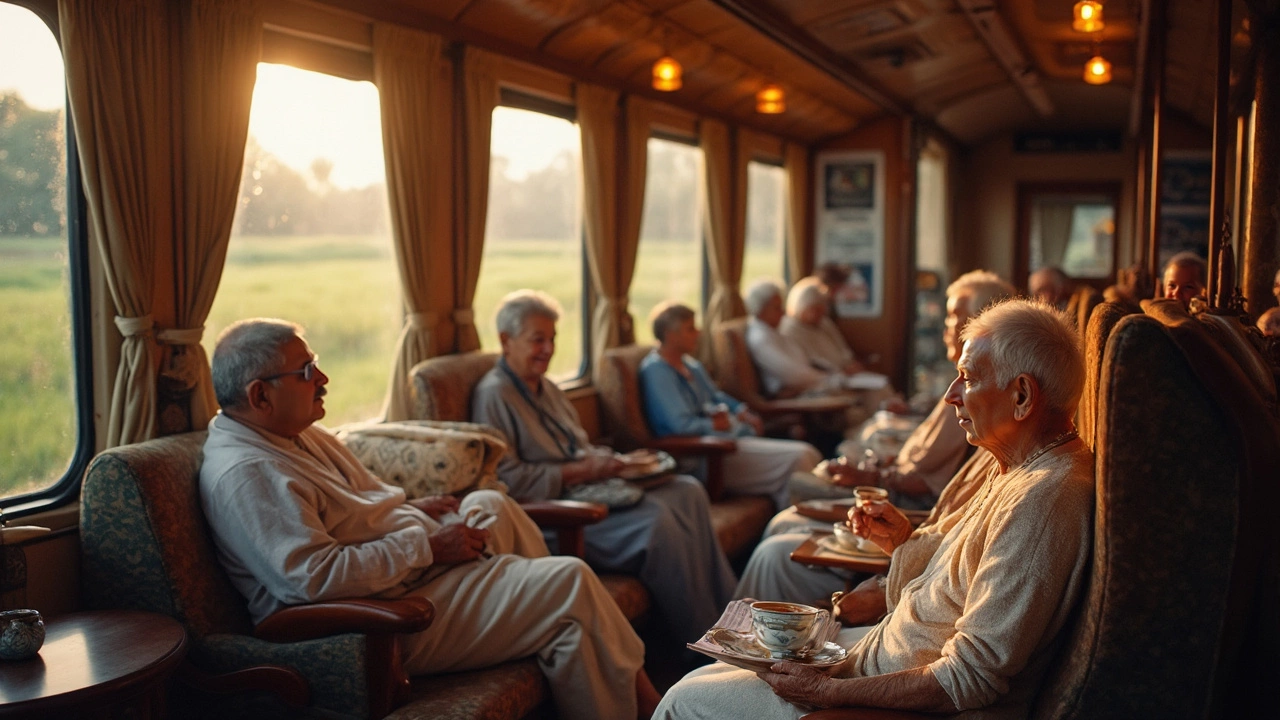Ever notice how some folks seem to get more adventurous with age, not less? That “bucket list” doesn’t just shrink—it grows, and with it, the itch to explore somewhere new, somewhere different. Yet, planes can be cramped and stressful, while driving long hours is exhausting no matter how many podcasts you line up. Train travel? It’s quietly having a golden moment—especially for seniors. But is hopping a train the smartest way for older adults to get around? Or is it just a romantic throwback with too many stairs and not enough legroom?
The Comfort and Ease: Why Seniors Prefer Trains
Sit back and think about the biggest travel headaches: airports with endless security lines, tiny airplane seats, cars stuck for hours behind blinking taillights. For many seniors, train travel wipes away those anxieties. Boardings are simpler—no taking your shoes off, no X-ray machines. Platforms are usually level, and boarding assistance is standard at many stations. On top of that, seats on modern trains often have more legroom than most first-class flights, and you can get up and walk whenever you please. Stretching your legs or finding a quieter car isn’t just possible; it’s encouraged.
Europe gets a lot of love for its high-speed rails—France’s TGV, Germany’s ICE, and Italy’s Frecciarossa aren’t just fast, they’re smooth, whisper-quiet, and offer generous senior discounts. But North America’s Amtrak has been making quiet improvements, too. Many Amtrak trains now offer priority boarding for seniors, wheelchair-accessible bathrooms, and big, panoramic windows that make you feel the scenery, not just see it. Even Canada’s VIA Rail, which covers some of the world’s most breathtaking routes, gets high marks for its accessible facilities and customer support for older passengers.
Now, comfort goes beyond just the seat. Trains have dedicated spaces for luggage—no hoisting heavy bags into tiny compartments overhead. Need dietary accommodations? You’ll find it easier to talk to staff in a train’s dining car, sometimes even order in advance. Traveling with medical equipment or a service animal? Unlike budget airlines, trains typically offer more space and support. It’s rare you’ll get charged extra for that rollator or oxygen tank.
The biggest surprise? It’s often just plain quieter. Unlike planes, where you’re stuck right next to crying toddlers or loud engines, train design tends to separate out social cars from the quiet zones. Many senior travelers swear by these peaceful carriages for reading, napping, or just staring out at the rolling countryside.
Perks, Discounts and Practical Benefits for Senior Rail Passengers
Here’s where the deal gets even better: seniors rarely pay full price. Take Amtrak—if you’re 65 or older, you get 10% off most fares, no blackout dates, no small print. VIA Rail in Canada is even more generous, slicing 10% or more off fares for those 60 or above. In Europe, the discounts are more complex—France’s Senior+ card offers up to 50% off on most TGV lines for just a small annual fee, while the UK has its famous Senior Railcard saving folks aged 60+ a steady 33% on nearly every train across Britain.
Some countries go the extra mile. In Switzerland, anyone over 60 can grab a ‘Swiss Half Fare Card’ and cut the cost of bikes, mountain trains, and ferries by half. Spain’s RENFE offers “Tarjeta Dorada,” dropping the price of intercity trains for seniors by up to 40% every single day. No haggling, no hoops—just proof of age.
Now, it’s not just about money. With a senior ticket comes flexibility. Lost your reserved train? Most senior fares let you hop on the next one for little or no penalty. Traveling with a partner? Many passes extend the discount to travel companions or caregivers at no extra cost. Feel like planning as you go, hopping off the train in a tiny town if it looks charming? Rail passes, especially in Europe, give that sense of freedom that planes or packaged tours never quite deliver.
A study published by AARP last year reported that over 65% of surveyed seniors rated ‘flexibility and stress-free travel’ as their #1 priority, beating out price or even destination. Trains check that box better than any other form of transportation. You can arrive minutes before departure, and changes or cancellations tend to be less of a bureaucratic nightmare than flight refunds or rescheduling car rentals. Suddenly, a late lunch or conversation with a new friend doesn’t risk blowing your entire itinerary.
Here’s a table highlighting some popular senior rail discounts and benefits in 2025:
| Country | Train Company | Senior Age | Discount |
|---|---|---|---|
| USA | Amtrak | 65+ | 10% off most fares |
| UK | National Rail (Senior Railcard) | 60+ | 33% off |
| France | SNCF | 60+ | Up to 50%, with Senior+ Card |
| Switzerland | SBB | 60+ | 50% off with Half Fare Card |
| Spain | RENFE | 60+ | Up to 40% off |

Safety and Accessibility: Are Trains Really Senior-Friendly?
Skeptical about safety? You’re not alone. The headlines make much of train derailments or mishaps, but the numbers tell a different story. According to the International Union of Railways (UIC), traveling by train in Europe is over 35 times safer than traveling by car, and North American statistics aren’t far behind. Unlike roads clogged with distracted drivers, trains run on dedicated tracks and are managed by staff trained for emergencies.
Accessibility matters more as we age. That’s been a big focus for rail operators, who’ve quietly stepped up their game. Many train stations now offer assistance from the curb all the way to your seat. Need help with your bags? Staff often meet you at the door. Worried about high steps? Modern trains in Europe, Japan, and now the US boast level boarding where the platform matches train floor height. For the rare station that isn’t accessible, you can usually book curb-to-seat help 24 hours in advance.
Train bathrooms tend to be bigger than those on planes, and there are often dedicated accessible restrooms in every other car. Seats can often be reserved in accessible areas, right by the luggage and restroom facilities. If you use a wheelchair, you’ll find spacious platforms and lifts in bigger stations, and ramps or portable lifts provided if not. British trains get high marks—over 90% of stations nationwide offer step-free access somewhere along the platform. In the US, all new Amtrak cars since 2021 are fully ADA-compliant, with wide aisles and tactile indicators.
One overlooked area? Visual and auditory assistance. Many trains have digital displays and voice announcements for each stop. For visually impaired seniors, tactile signs and contrasting handrails are more common than ever. If you have hearing concerns, ask about induction loops—special sound systems for hearing aids, common on UK, Dutch, and some US trains.
Safety is about more than tracks and ramps, though. Train staff patrol every car, so if you need medical help or feel unwell, it’s easy to get assistance—sometimes faster than it would take for a flight attendant to reach you. Here’s what the National Institute on Aging shared in a recent report:
"Modern passenger trains have become a practical, safe, and increasingly accessible way for older adults to maintain their independence while enjoying travel. The built-in social aspect also helps combat isolation—a known risk for seniors."
If you’re on medication or worried about emergencies, trains make things simpler. Pack your regular bag, keep medications handy, and if you need urgent help, staff can coordinate stops and get you off at the nearest staffed station, not just the next airport hours away.
Scenery, Social Life, and Quality of the Journey
Let’s be honest—sometimes it’s not just about the destination, but the ride itself. Ask anyone who’s taken the Empire Builder through the Pacific Northwest or the Glacier Express through the Swiss Alps and they’ll tell you the views from a train window beat any inflight movie. Trains go places that cars and planes can’t—snaking along river valleys, dipping through tunnels, climbing into snowy peaks. For seniors who value a slower pace or want a trip that’s as much about the journey as the endpoint, this can be a game-changer.
Trains are social spaces, too. Unlike airplanes, where everyone tries to ignore their seatmates, train culture is friendly. It’s not rare to strike up conversations in the dining car that last the whole trip. Long-haul routes in the US—think the California Zephyr or the Coast Starlight—are almost legendary for their community feel. If you like meeting people, you’ll quickly find fellow travelers, often from all over the world, many who are also seniors or retirees. Some even connect over board games or book swaps.
Prefer solitude? That’s easy. Head to a quiet car, plug in some headphones, and zone out with your favorite music while miles of farmland or mountain scenery roll by. For art lovers, some European lines even have on-board exhibitions or local history talks during scenic stretches. You never have to sit still, either—walk the train, choose seats by the window, grab a coffee, or just watch the scenery blur past.
Food is another high point. Modern trains have ditched the rubber chicken stereotype. On French TGVs, you can sip wine from Bordeaux paired with local cheeses; on Japanese Shinkansens, vendor carts bring bento boxes to your seat; even Amtrak’s long-distance lines offer richer menus than airlines can manage. If you have specific dietary needs, staff are usually well-trained and happy to help—it’s not unusual for repeat passengers to get to know attendants by name.
Don’t underestimate the feeling of freedom, either. Along a train journey, you can stop in places you’d never see from a plane. Want to spend a night in a small German village, or see a hidden part of the Rockies? Hop off. Trains deliver you right to the center of town, not a far-off airport, and connections are a breeze.

Tips for Seniors to Get the Best Train Experience
Ready to hop on a train? Let’s cover some trade secrets and practical tips to turn your next journey from just good to unforgettable.
- Book early to lock in senior discounts and the most accessible seat options. Many trains let you select seats online; don’t assume all the best spots are taken last-minute.
- If you use mobility aids, call the rail company before your trip. They can reserve ramps, early boarding, and even meet you at arrival.
- Travel light, but bring a small rolling bag for on-the-go essentials. While trains have luggage cars, the bag you bring to your seat is your best asset.
- Ask about quiet cars or observation lounges. Not every train advertises these, but they’re gold for those who want peace or panoramic views.
- Don’t forget snacks and water—even premium trains sometimes run out of favorites. Pack what you like, especially for dietary needs.
- Layer your clothes. Trains are usually well-heated or air-conditioned, but unpredictable weather means being prepared makes everything smoother.
- Keep your travel documents, ID, and rail card handy. Most senior discounts are only valid with photo ID, and ticket inspectors often ask for both.
- If you travel in a group or with a carer, check if both of you are eligible for discounts or combined tickets.
- Make stops part of your journey. Some of the best stories come from random towns along popular lines.
- Talk to staff and fellow passengers—many are full of local tips you won’t find in guidebooks.
Despite all the perks, every individual’s needs are unique. Those with specific health concerns should talk with their doctor before long trips and keep medical info handy. Most major rail operators have special help hotlines—never hesitate to call ahead. And know this: If you haven’t tried train travel since you were a kid, you’ll be stunned how much the ride has changed.



